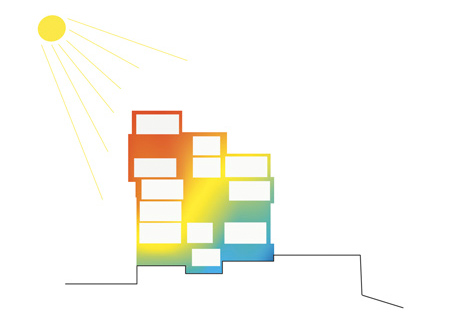
In his writing form and function follow climate Philippe Rahm suggests a new architectural concept which differs from classical approaches such as form follows function or function follows form. Rahm claims that form has to be developed in response to climate conditions and that sustainability is due to be the guideline for architectural advancement.
Rahm investigates the relationship between human and nature. He advocates a transformation of conventional spatial organization into a free space which is not limited by specific functions.
In his work, Rahm identifies sustainable development to be the essential challenge of architecture in the 21st century. In his view we have to reconsider conventional habits and patterns to establish innovative and sustainable buildings. He considers advanced technologies as part of this changing process which will eventually affect the form and function of prospective architecture.
Rahm investigates the relationship between form and function by referring to Louis Sullivan’s statement of form follows function which simplifies architecture as a spatial expression of the functional program on the one hand and Louis Kahn’s contradicting concept of function follows form which defines the functional program as flexible in response to a system of hierarchies on the other hand.
However, Rahm proposes an alternative perception of spatial organization considering the climate as a leading factor for architectural design. He states that form and function have to follow climate. In Rahm’s point of view space has to be adaptable according to season and weather conditions as well as to human needs and desires. Rahm proves that our built surroundings can be reinterpreted and functionally changed as for example the campi in Venice which were originally meant to be catching systems for rainwater, but serve as social and cultural meeting points by now.
According to his work, Rahm considers the climate as crucial for any future architectural development.
Furthermore, he questions traditional spatial organizations and proposes a concept of interpretable architecture to liberate space from function and provide individually adaptable space instead.
In conclusion, Rahm suggests to emerge function and form spontaneously according to the climatic conditions and individual needs. Architecture has to be a response to changes of the physical and cultural environment.
The case study deals with a project called Never Never Land designed by Andrés Jaque Architects located in San José, Ibiza. About 80% of the building has been raised above ground in order to preserve the natural environment. The geometric configuration is intended to sustain most of the existing trees which indicates a positional relation.
The spatial organization of Never Never Land is very unusual. Exterior and interior spaces are strongly connected to establish an interaction between architecture and the surroundings. The rooms for intimacy and those for group actions are assembled to create an open living zone.
Reconsulting the writing of Philippe Rahm it is noticeable that some of his basic ideas about advanced architecture are matching the case study project. The Never Never Land project deals with sustainability and environmental responsibility as well as with unconventional spatial planning.
Nevertheless, the project of Andrés Jaques Architects relates to the natural surroundings only superficially which is why I would not consider it as advanced architecture.
The climate change and the greenhouse gas production are currently increasing the global warming more and more. Acting environmentally respectfully and taking concepts as Rahm’s form and function follow climate in consideration during the design process has become crucially relevant. In my opinion preserving our environment and investigating in our natural surroundings is an essential part of advanced architecture.
Architecture of cities and buildings has become an element of the “ecosystem nature”. In my point of view advanced architecture means respecting this system we live in and relating to it.
I consider it as an opportunity as well as a duty to preserve our natural environment and in the best case improve it.
personal research proposal:
Rhizome is a philosophical concept developed by Gilles Deleuze and Félix Guattari as part of the Capitalism and Schizophrenia project. Rhizome is defined as a system of interaction based on the botanical rhizome. The Rhizome Theory provides a multiple, non-hierarchical classification system which follows no specific pattern or organizational regulations.
During my research I would like to investigate in the Rhizome Theory considering how it could be related to spatial and urban organization as well as to human society. In this context it will be challenging to discover how the Rhizome Theory can be related to the concept of Relational Logics.
photo credits: www.philipperahm.com
